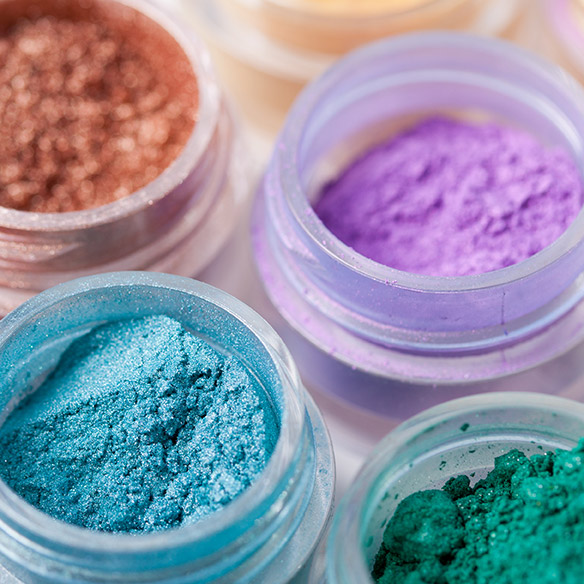Soap Dyes & Pigments

Here at The Soap Kitchen we keep a comprehensive selection of dyes, pigments and other colours including natural dyes, mica pigments and glitters perfect for adding character to your soap making.
Colouring soaps and toiletries can be a confusing process, here is a little overview to help you...
In simple terms, soap dyes and soap pigments differ in one important aspect which is particle size. A soap dye has a very small particle size and as such is ideal for colouring transparent products such as clear melt and pour soaps or clear liquid toiletry bases where transparency and dispersion are important. Soap pigments, on the other hand, have a far larger particle size and will opacify transparent substances, so are far more suited to colouring opaque products but there are advantages and disadvantages to both dyes and pigments.
Limitations that apply to both soap dyes and pigments are generally as follows... Dyes will usually disperse and suspend perfectly in liquid products such as foam baths, shower gels etc. but, where used in a transparent solid base such as melt and pour soap they will, over time, travel (bleed) so if you are layering or embedding colour in a transparent soap you should be careful to only use dyes where there is no problem if the colour bleeds into an adjoining colour. If colour bleed is a problem then choose to use pigments where necessary and where transparency is not important, for instance where you embed a coloured shape within an otherwise transparent soap bar. Pigments, on the other hand, with their larger particle size, will sink-out of most liquid products, but are extremely useful in adding colour to opaque solid products.
Other limitations to both soap dyes and soap pigments are more to do with what product you are trying to colour and more specifically what pH value the product has together with other variables such as light stability. Most soap pigments are tolerant of a wide pH spectrum and are therefore suitable for colouring cold process soaps (sometimes known as cold pressed soaps) because they can withstand the alkali conditions. Many dyes will be more stable in a more neutral or even an acid environment and as such would not always be the best choice for colouring a cold process soap. As with all these things the rules are general rather than specific and there are several exceptions, so always check that the dye or pigment you're choosing is suitable for the product you wish to colour. Light stability is also an issue and which almost exclusively affects soap dyes. Blue dyes are often the least stable when exposed to light, causing them to fade, so many dyes which are themselves blue or are mixtures such as a green being a mix of a yellow dye and a blue dye may not keep their colour well if exposed to bright sunlight such as where they may be displayed on a shelf for sale.
Our website offers a wide selection of soap dyes and pigments for sale and in most cases, there is at least some guidance as to how stable each one is in a particular use. Both dyes and pigments can be found in liquid and powder format. When purchased as a powder typically a pigment will give a colour very similar to that of its powder form. A dye, however, can look quite different in powder form and should not ever be used without first diluting it in water which will reveal its correct colour and also ensure it properly disperses in the product you're colouring. Powdered pigments can be used in dry products such as bath bombs, as a powder, but would be far better used in a soap as a dispersion in a little water which will help prevent 'spots' of colour developing. Where a dye or pigment is sold in a liquid form it is dilute and is designed to be used as it is. There are also a family of pigments generally known as 'insoluble pigments' of which we have a few available. These are typically a powdered pigment that is insoluble in water but will disperse in oils or solvents. These are most useful to the soap maker for colouring the soap making oils which can then be used to make a coloured cold process soap. Confusingly there are also a limited number of water-dispersible insoluble pigments which are not to be confused with dyes. These are actually combinations of the insoluble pigment and a surfactant which renders the substance dispersible in water. These are most useful to the soap maker where transparency can be well maintained if used sparingly but where colour bleed needs to be avoided, such as when used in adjacent layers of a melt and pour soap, especially where one coloured layer is required to remain transparent
Guidelines for use... Always take great care in handling dyes and pigments. Avoid spills wherever possible and always clear up spills immediately. When handling powders take great care to avoid dust, especially with powdered dyes, as the lightweight dust can settle on surrounding surfaces where moisture in the air will cause them to bleed their colour onto that surface, which can cause damage which can then be difficult to clean. If diluting a powdered dye, use a maximum ratio of 5% dye powder in 95% water (by weight) and if keeping a diluted dye for future use ensure you add a suitable preservative to give the resulting liquid dye adequate shelf life. We would always recommend wearing disposable gloves when handling any liquid dyes or pigments and also a face mask when handling powders.





